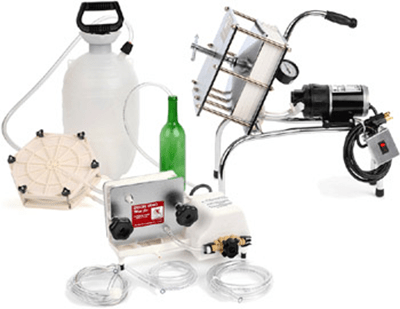 When should I filter my wine? I have a wine that is about 4 months old and I’m wondering if it is to early to filter it.
When should I filter my wine? I have a wine that is about 4 months old and I’m wondering if it is to early to filter it.
Don
—–
Hello Don,
When first learning how to make your own wine it is important that you don’t become too impatient, however since the wine has been bulk-aging for 4 months, I would say you’ve been patient enough. It would be fine to filter your wine at this time.
One of the more common wine making tips I share with beginning winemakers is:
“Never filter a cloudy wine. The wine should be done fermenting and look clear before filtering”.
You can verify that the wine is done fermenting by testing it with a wine hydrometer. You should be getting a test reading of .998 or less. For more information about this you may want to take a look at the article, “Getting To Know Your Hydrometer” listed on our website.
A wine filter is not designed to remove visible particles from a wine. A wine filter is designed to take out very fine particles, smaller than the human eye can see. This gives the wine a beautiful, polished appearance. It brightens the wine.
With this in mind, it is important to make sure that all the sediment that can fall out of the wine on its own has done so, otherwise the extremely fine filter pads that are used in the wine filter will clog up very quickly.
 If you are making wine from wine concentrates, the sediment will fall out fairly easily on its own in a week or two, but if you are making wine from fresh grapes or some other fruit, getting all the sediment to drop out can sometimes be challenging. For this reason, it is suggest that you treat the wine with bentonite before filtering.
If you are making wine from wine concentrates, the sediment will fall out fairly easily on its own in a week or two, but if you are making wine from fresh grapes or some other fruit, getting all the sediment to drop out can sometimes be challenging. For this reason, it is suggest that you treat the wine with bentonite before filtering.
Speedy bentonite is a fining agent that will help speed up the natural falling-out of the sediment so you can filter your wine sooner and more efficiently. To learn more about fining agents you may want to reading the article, “Using Finings To Improve Your Wine“.
You will also want to rack the wine off the sediment before filtering the wine. This will eliminate the chance of drawing sediment into the wine filter.
There is another, more simple, way to answer the question: When should I filter my wine? Filter the wine when it is ready to be bottled. Make it the last step the wine goes through before it is put to rest in the bottle. There is no advantage to filter the wine before that time.
Happy Wine Making,
Ed Kraus
—–
Ed Kraus is a 3rd generation home brewer/winemaker and has been an owner of E. C. Kraus since 1999. He has been helping individuals make better wine and beer for over 25 years.
Category Archives: Q&A
Can I Add Liqueurs To Homemade Wine?
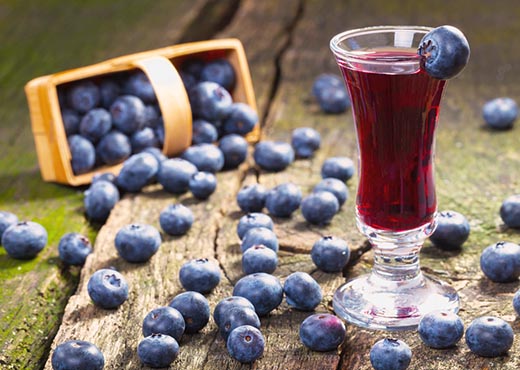 Can I add liqueur to my wines? I have added brandy to some, blackberry, peach. Will it change the taste?
Can I add liqueur to my wines? I have added brandy to some, blackberry, peach. Will it change the taste?
Tino — NY
—–
Hello Tino,
Absolutely, you can add liqueurs to your homemade wine. I always like to encourage experimentation. Without it, nothing moves forward.
Adding a brandy or liqueur to a homemade wine puts it in the category of a fortified wine. Brandy is added to wines to produce Ports, Sherrys, Maderas and others. They typically will run around 18% to 21% alcohol. This is not uncommon at all. On a commercial level, adding liqueurs is not commonly done, but certainly has some great potential. Why couldn’t you add peach schnapps or peach brandy to a peach wine? It would raise the alcohol and intensify the flavor.
Obviously, you have to use some common sense in your combinations. The flavors needs to be complimentary to one another. For example you wouldn’t want to use orange brandy with a blueberry wine. You want to stay within reason.
I would also suggest that you take baby-steps. Do a bench-testing, first. Add the chosen liqueur to a sample of the wine. This does two things: 1) it allows you to establish a dosage ahead of time that can later be applied to the entire batch; 2) it acts as a safety-net; it you accidentally add too much to the wine sample, you can put the sample back with the rest of the batch and start all over.
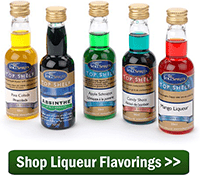 As a side note, we sell liqueur flavorings for transforming vodka, brandy and the likes into various liqueurs. They come in tiny bottles for making a quart or two at a time. You just add them to the alcohol base, sometimes with sugar, to create an array of liqueurs.
As a side note, we sell liqueur flavorings for transforming vodka, brandy and the likes into various liqueurs. They come in tiny bottles for making a quart or two at a time. You just add them to the alcohol base, sometimes with sugar, to create an array of liqueurs.
Home winemakers will use liqueur flavorings to enhance the flavors of their wine. For example, you can use the pear brandy liqueur flavoring directly to a pear wine to increase the wine’s fruitiness. It will not raise the alcohol level of the, but it will add a noticeable amount of flavor.
Also realize, that it is possible to have too much alcohol in a wine. A wine can go out of flavor balance if it becomes too hot or alcoholic. When this happens the wine will start to taste more watery, less flavorful, less fruity. This is because of the numbing effects that alcohol can have on the senses, both taste and smell. This is one good reason to look at liqueur flavorings instead of liqueurs. You get the flavor without the heat.
Regardless, I think adding liqueurs to homemade wines is a fantastic way of playing around with the flavors in your wine. I can be valuable. Not only can you come up with something spectacular, you get to exercise your senses in a way that will only help you with future batches of homemade wine. Just remember to take careful steps, and do sample tests before moving forward with the whole batch of wine.
Happy Winemaking,
Ed Kraus
—–
Ed Kraus is a 3rd generation home brewer/winemaker and has been an owner of E. C. Kraus since 1999. He has been helping individuals make better wine and beer for over 25 years.
Sweet Idea! Adding Fruit To Wine Kits
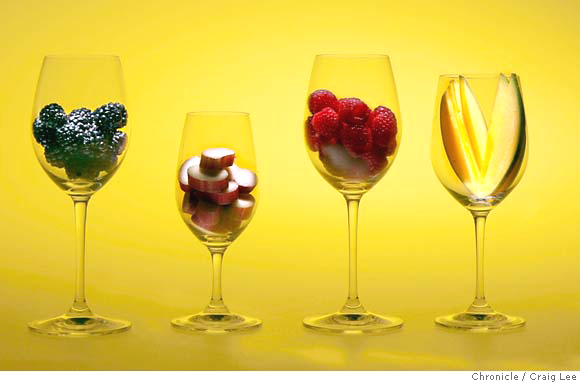 We did a Chardonnay wine kit recently. The results were very good, by all accounts. What is your position on mixing peach, apricot or even persimmon into a batch of that? Wondering. Thanks in advance for your time.
We did a Chardonnay wine kit recently. The results were very good, by all accounts. What is your position on mixing peach, apricot or even persimmon into a batch of that? Wondering. Thanks in advance for your time.
Jeff
—–
Hello Jeff,
Adding fruit to wine kits is a great way to enhance any attractive characteristics that a particular grape may possess. For example: raspberries with Merlot grapes, strawberries with Zinfandel, pears with Pinot Grigio… The options are endless and there is always room for experimentation. It’s a great way to have even more fun while making these wines.
Usually when a home winemaker wants to make a wine in this style, they will mix the wine kit and fruits together in the fermenter and proceed with the fermentation from there. After the primary fermentation has completed, the fruit is then removed as the wine goes into a secondary fermenter. However there is another – more professional – way for adding fruit to wine kits. One that will give you much better control over the end product. In other words, less chance of messing up.
Instead of mixing the grape concentrate and fruit together at the beginning of fermentation, make the chosen fruit into its own wine, separately.
In the case of your Chardonnay, you could make some peach wine – one or two gallons of it. When it is time to bottle, you can experiment with blending some or all of the peach wine with it. 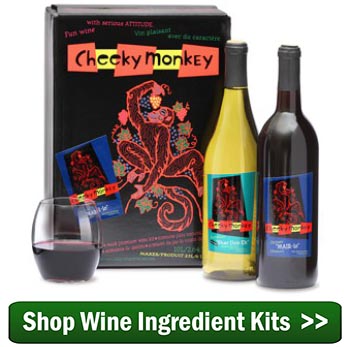
How much peach flavor you add is a matter of personal taste. You can add a little or a lot. You could do sample taste-testings with varying ratios of the two wines. This is the real power of making the two wines separately. You have complete control over the outcome. If you had added some fruit like peaches at the beginning of fermentation, all you could do is guess as to how much peach to add and hope for the best.
By adding fruit to wine kits in this way, you will have total control over how much fruit flavor is in the wine. This method will also allow you to safely mix blending samples together without risking your entire batch.
We have more information about blending wines together in an article on our website that you may want to take a look at: Blending To Improve Homemade Wines. This article should give you some better insights as to what you are look for when putting two wines together.
As far as whether to try peach, apricot or persimmon, all I can say is that I have seen the most success using peach verses apricot and I have never tasted persimmon added to a Chardonnay. But having said this,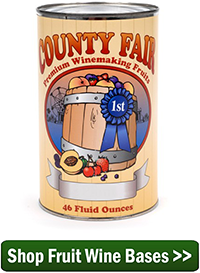 I would never tell you not to try any combination. There are no wrong answer when adding fruit to wine kits. Home wine making is about being creative, experimenting and seeing what you can come up.
I would never tell you not to try any combination. There are no wrong answer when adding fruit to wine kits. Home wine making is about being creative, experimenting and seeing what you can come up.
Happy Wine Making,
Ed Kraus
—–
Ed Kraus is a 3rd generation home brewer/winemaker and has been an owner of E. C. Kraus since 1999. He has been helping individuals make better wine and beer for over 25 years.
2 Great Questions About Bottling Homemade Wine
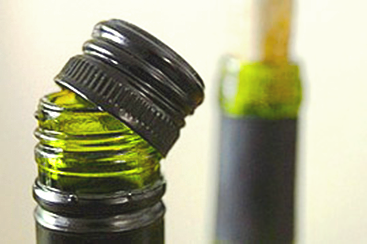 1. Are the mushroom cork or t-corks easy to install, or do you need special equipment. Do they seal as well as regular wine corks, (over time)?
1. Are the mushroom cork or t-corks easy to install, or do you need special equipment. Do they seal as well as regular wine corks, (over time)?
2. Wine bottles that have a screw top, can you reuse them with a wine cork?
Name: Tom H.
State: Davison, MI
—–
Hello Tom,
The T-corks (mushroom corks) are very easy to install. This is the biggest advantage to using them over traditional wine bottle corks. You do not need a wine bottle corker or any mechanism of any kind. You simply put T-corks in by hand. Every now and then you may get a stubborn one, but that can easy be remedied by tapping on it with a rubber mallet or similar.
The biggest disadvantage with T-corks is that they are not meant for long-term storage. Some wines made from fresh grapes or maybe elderberries may require several years of aging. These are not the corks to use for that situation. We recommend using T-corks for wines that you intend to drink within a one to two years.
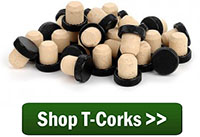 As to your second question about using wine bottle corks on a screw-cap wine bottle, the answer is “not advisable”. This is for two reasons. The first is that the size of the opening of the wine bottle is critical to the success of the wine bottle cork. The wine bottling opening needs to be 3/4″. This is not the case with most screw-cap wine bottles. They are all close, but usually off a bit.
As to your second question about using wine bottle corks on a screw-cap wine bottle, the answer is “not advisable”. This is for two reasons. The first is that the size of the opening of the wine bottle is critical to the success of the wine bottle cork. The wine bottling opening needs to be 3/4″. This is not the case with most screw-cap wine bottles. They are all close, but usually off a bit.
The second reason, and the one that is most important, is the shape of some screw-cap wine bottles are not correct to accept a wine bottle cork. The opening of the wine bottle needs to be a straight barrel. With some screw-cap wine bottles the barrel is not straight. The shoulder of the wine bottle rises too high to accommodate a straight barrel opening that a wine bottle cork needs, so what you end up with is a slightly-flared barrel opening.
Without this straight-barrel opening two things can happen:
- The
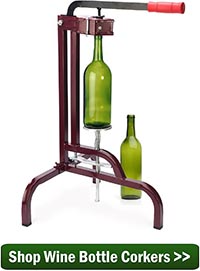 cork does not seal tightly enough along the whole length of its side. As the barrel opening flares out, the resistance against the side of the cork becomes less and less.
cork does not seal tightly enough along the whole length of its side. As the barrel opening flares out, the resistance against the side of the cork becomes less and less.
- Because of this flaring and uneven resistance, it can actually entice the wine cork stopper to pull down into the bottle. I’ve seen this happen more than once. Think of squeezing a marble between your fingers. If you don’t squeeze it evenly or to one side, it pops out. This is the same effect that can happen when corking a screw-cap bottle that has a flared barrel.
Thanks for the great questions, Tom.
Happy Winemaking,
Ed Kraus
—–
Ed Kraus is a 3rd generation home brewer/winemaker and has been an owner of E. C. Kraus since 1999. He has been helping individuals make better wine and beer for over 25 years.
My Homemade Wine Is Too Dry. Is There Anything I Can Do?
 I have a mustang grape wine that has been aging in a carboy. Last night I tried and it has a hydrometer reading of .992. When I tasted the wine, it was too dry for me. How can I sweeten up this wine to a semi sweet?
I have a mustang grape wine that has been aging in a carboy. Last night I tried and it has a hydrometer reading of .992. When I tasted the wine, it was too dry for me. How can I sweeten up this wine to a semi sweet?
John
_____
Hello John,
One of the great things about making your own wine is that you get to drink it the way you want to – even if you want to drink it like our buddy Zach Galifianakis does. For me personally, this is the fun part of making homemade wine. Adjust it until you get the wine just the way you like it. This is something that can’t practically be done unless you are making the wine yourself. This is what makes this hobby so valuable.
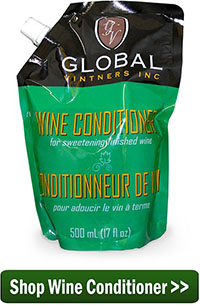 In your case, you are not particularly happy with one of the basic features of the wine: the dryness or sweetness of the wine. You are saying that your homemade wine is too dry for your own personal taste. Fortunately, the solution is very simple. All you need to do is add sugar to the wine until it is at the sweetness you desire – custom made for you!
In your case, you are not particularly happy with one of the basic features of the wine: the dryness or sweetness of the wine. You are saying that your homemade wine is too dry for your own personal taste. Fortunately, the solution is very simple. All you need to do is add sugar to the wine until it is at the sweetness you desire – custom made for you!
It is important to remember that you do not want to adjust the sweetness of a wine until it has completely cleared up and is ready to bottle, so make sure the wine is ready to be bottled before adding the sugar.
At bottling time you can make the wine sweeter tasting. One of the easiest ways of doing this is to use Wine Conditioner. This is basically a sweetener and stabilizer combined together into a syrup. The stabilizer (potassium sorbate) makes sure that your wine does not start fermenting the new sugars while in the wine bottle.
You can also use your own sugar, honey, etc. to sweeten your wine, but you will also need to add potassium sorbate separately to eliminate any 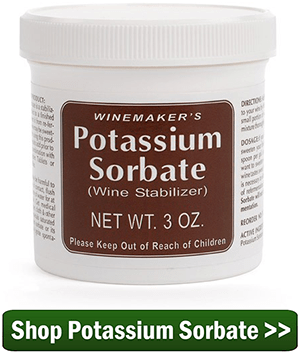 chance of the wine re-fermenting. So, as I think you can start to see, if your homemade wine is too dry, it’s not that big of a deal to fix.
chance of the wine re-fermenting. So, as I think you can start to see, if your homemade wine is too dry, it’s not that big of a deal to fix.
If the sugar you are using is granulated, I would also suggest that you pre-dissolve the sugar into a syrup before adding it to the wine. This will help to eliminate the need for excessive stirring when adding the sugar.
When actually sweetening your wine it is best to sweeten a portion of the batch, first. For example, take a measured sample of the wine – say, one gallon – and add measured amounts of sweetener to it to establish a dosage to your liking. Once the dosage is determined you can then do the same thing to the rest of the wine. This insures that you do not get the entire batch too sweet.
 If you do accidentally add too much sugar to the measured sample, just blend it back into the rest of the batch and start all over with a new gallon sample.
If you do accidentally add too much sugar to the measured sample, just blend it back into the rest of the batch and start all over with a new gallon sample.
We also have an article on our website, Making Sweet Wines, that will have more information about what to do if your homemade wine is too dry. You may want to take a look at it as well.
Happy Wine Making,
Ed Kraus
—–
Ed Kraus is a 3rd generation home brewer/winemaker and has been an owner of E. C. Kraus since 1999. He has been helping individuals make better wine and beer for over 25 years.
There's A White Scum On Top Of My Homemade Wine
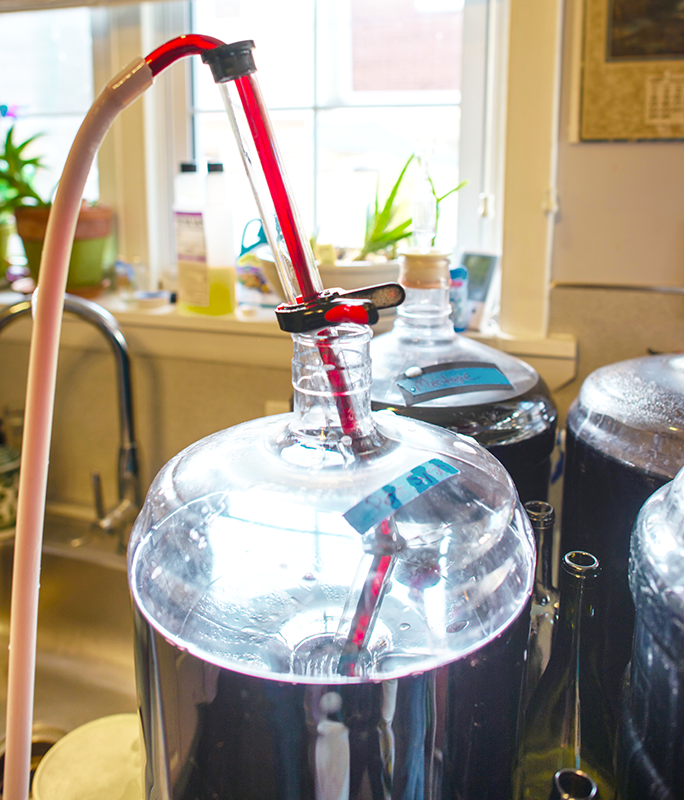 Bill has made a few small batches of home wine, and all went well. This year we did a strawberry-rhubarb and on the third racking in a 5 gal jug, it developed a thin white scum over the center of top. We could get past the film to re-rack, but Bill is concerned it is ruined…is it? Has this white scum on top of his homemade wine ruined it?
Bill has made a few small batches of home wine, and all went well. This year we did a strawberry-rhubarb and on the third racking in a 5 gal jug, it developed a thin white scum over the center of top. We could get past the film to re-rack, but Bill is concerned it is ruined…is it? Has this white scum on top of his homemade wine ruined it?
Name: Gidget M.
State: PA
—–
Hello Gidget,
What this sounds like is something called flowers or flowers of wine. It starts off as patches of white scum or a white film. If left uncheck it can grow to cover the entire surface of the wine. It is actually a small bacterial growth on the wines surface.
Just because the wine has this white scum or film on top does not mean it is ruined by any means, but some actions should be taken to see that it does not get any worse.
Just as you have suggested, you need to rack the wine away from the bacterial growth. Draw the wine from the center of the fermenter, passed the white film on top, but not from the vary bottom, either. Once you get it racked, dose it with either Campden tablets, potassium metabisulfite or sodium metabisulfite. Any of these will easily destroy any bacteria cells that may still be in the wine.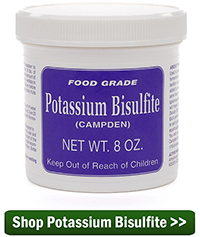
What allowed the white scum on top of your homemade wine to occur in the first place was having too much head-space in with the fermenter with the wine. This is okay during a fermentation, when CO2 gas is coming off the liquid, but after the fermentation the head-space needs to be eliminated.
It is the air in contact with the wine that can promote a bacterial growth such as the one you are experiencing. In the future, after the fermentation has completed, I would suggest that you keep whatever fermenter the wine is in topped-up. There are many ways you can top-up a fermenter. You can read more about this in the follow article: Topping Up Your Homemade Wines.
I would also recommend that you automatically add one of the three forms of sulfite mention earlier after the fermentation. This will dramatically help keep your homemade wines from getting this white scum or film.
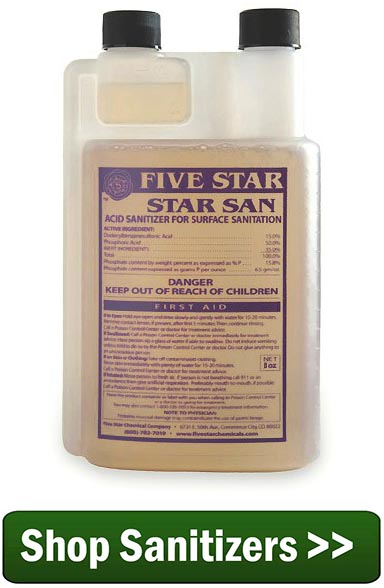 Going back to your strawberry/rhubarb wine, it is fine. Based on your description, it does not sound like the white scum or film advanced enough to affect the wine’s flavor in any significant way. If sulfites are added to the wine, flavor and aroma would be the only concern to take into consideration. Rack the wine, and add sulfites.
Going back to your strawberry/rhubarb wine, it is fine. Based on your description, it does not sound like the white scum or film advanced enough to affect the wine’s flavor in any significant way. If sulfites are added to the wine, flavor and aroma would be the only concern to take into consideration. Rack the wine, and add sulfites.
Once the wine has cleared and is ready to bottle, sample it and see what you think. The wine will be perfectly safe to drink. You are only noting the flavor and aroma.
Happy Winemaking,
Ed Kraus
—–
Ed Kraus is a 3rd generation home brewer/winemaker and has been an owner of E. C. Kraus since 1999. He has been helping individuals make better wine and beer for over 25 years.
My Peach Wine Will Not Clear
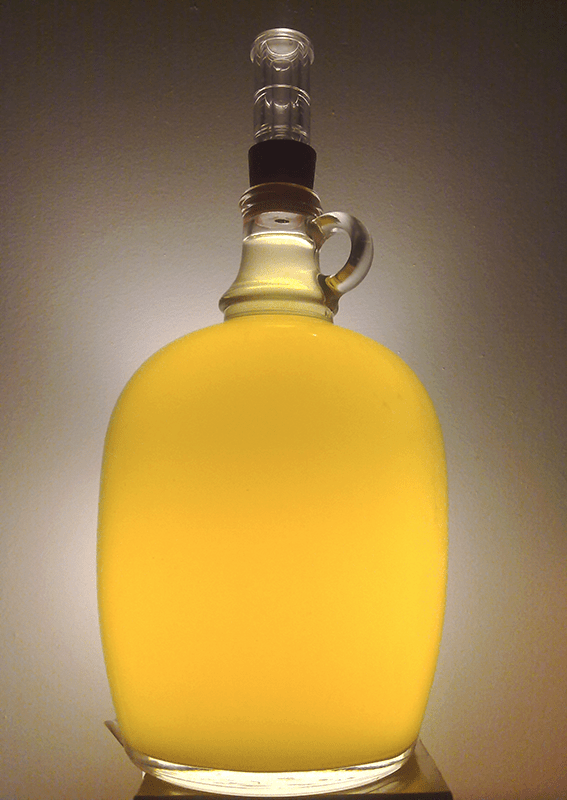 I have a peach wine that has a haze to it. The wine will not clear. It has been chilled for 2 weeks after fermentation, racked 4 times and I have added fining agents. It cleared to this fine haze but will not clear any further. Is this a wine that is not going to completely clear and I just need to live with it? Oh yea, there was pectic enzyme added at the start. What are your thoughts? Thanks
I have a peach wine that has a haze to it. The wine will not clear. It has been chilled for 2 weeks after fermentation, racked 4 times and I have added fining agents. It cleared to this fine haze but will not clear any further. Is this a wine that is not going to completely clear and I just need to live with it? Oh yea, there was pectic enzyme added at the start. What are your thoughts? Thanks
Name: Echota
State: TN
—–
Hello Echota,
Base on information you have given, it sounds like the reason your homemade wine will not clear is because you have a pectin haze, even though pectic enzyme was added at the beginning.
Fining agents will take out the particles in a wine that can cause it to be cloudy, but a pectin haze is different. It is not caused by particles. It is caused by the actual make up of the liquid itself. The pectin chemically bonds to the wine, making it impossible to clear with just fining agents such as bentonite or isinglass.
The standard dose of pectic enzyme called for in most wine recipes is enough to breakdown and drop out a usual amount of pectin from the fruit, but in some instances the amount of pectin in a wine must can be unexpectedly large. This leads to the situation you are describing where your homemade wine will not clear, completely.
One way to know for sure if your wine is experiencing a pectin haze is to take a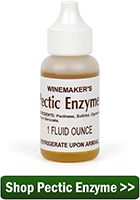 sample of the wine, say a half-full quart mason jar, and add a ridiculous amount of pectic enzyme to it. If the wine clears without leaving any sediment, then you know that a pectin haze is the reason for you wine being cloudy.
sample of the wine, say a half-full quart mason jar, and add a ridiculous amount of pectic enzyme to it. If the wine clears without leaving any sediment, then you know that a pectin haze is the reason for you wine being cloudy.
If the wine clears, but leaves sediment behind, then you know it is a particle haze – not a pectin haze – and more time, gravity and fining agents is the answer to resolving this issue.
Clearing up a stubborn pectin haze in a wine after the fermentation has stopped is somewhat difficult, but it can be done. It’s simply a matter of adding more pectic enzyme to the wine.
The problem really lies with the fact that the fermentation is no longer fermenting. This causes the pectic enzyme to take longer to do it’s thing, so some patience will be needed. It could take as long as a month or two for the pectic enzyme to clear up the wine completely.
If you are using our liquid pectic enzyme the standard dose is 1/8 teaspoon for each gallon of wine. However, in this situation you want to add a double dose of 1/4 teaspoon per gallon of wine. This is in addition to any pectic enzyme you added at the beginning of fermentation. If you are using a powdered pectic enzyme the story is the same. Add double the recommended dosage listed on the package and give it time.
at the beginning of fermentation. If you are using a powdered pectic enzyme the story is the same. Add double the recommended dosage listed on the package and give it time.
When ever a homemade wine will not clear you always want to look towards protein particles such as yeast cells, tannin, etc to be the cause. These are things that can be easily dropped out with fining agents and wine clarifiers. But whenever you get into a situation where that last little bit will not clear out of the wine, no matter what you try, then it’s time to start suspecting a pectin haze to the reason your wine will not clear.
Happy Winemaking!
There Are Black Spots In My Wine
 I have made a number of batches of fruit wine and consumed most of it. This is the first time I have used cherimoya in a persimmon blend. Cherimoya is a very sweet fruit, large amounts of sediment, and does not fully clear after racking it four times.
I have made a number of batches of fruit wine and consumed most of it. This is the first time I have used cherimoya in a persimmon blend. Cherimoya is a very sweet fruit, large amounts of sediment, and does not fully clear after racking it four times.
The bottled wine is stored on its side in a dark environment for 6 months. Placing a bottle on its side creates a small air bubble at the top most section of the bottle. A black spot appears on the inside of the bottle within the air bubble. Most of these black spot will merge with the wine after the bottle is turned upright for a day or so.
What is this black spot in my wine?
Name: Mark A.
State: Hawaii
—–
Hello Mark,
It’s hard to know precisely what these black spots in your wine are, but normally we associate having black spots in your wine with either a mold or bacteria growth. Combined with the fact that it is appearing where there is an air pocket in the wine bottle, I would say that it is more likely to be a growth of some sort. This is where you would typically see mold or bacteria to start to grow – next to the air.
 If you did not add a sulfite to your wine before bottling such as: Campden tablets, potassium metabisulfite or sodium metabisulfite, this would strongly add to my belief that a mold or bacteria is trying to grow in your wine. Sulfites are needed to help protect the wine from spoilage while it is in the wine bottle.
If you did not add a sulfite to your wine before bottling such as: Campden tablets, potassium metabisulfite or sodium metabisulfite, this would strongly add to my belief that a mold or bacteria is trying to grow in your wine. Sulfites are needed to help protect the wine from spoilage while it is in the wine bottle.
In addition to bottling time, you should also be using Campden tablets in the wine must before the fermentation. This is to rid the wine must from contaminates that may have come along with the fruit. The sulfites are added 24 hours before the wine yeast. Leave the the fermenter uncovered during this 24 hours to allow the sulfites to dissipate, otherwise they can interfere with the fermentation.
If you did not sanitize your wine bottles in addition to cleaning them with soapy water, this would also make me think that you are dealing with a mold or bacteria and could easily be the reason you have black spots in your wine. Cleaning the grime from the wine bottles is not good enough. They need to be sanitize with something like: Basic A or B-Brite. Any of these will easily destroy the microscopic contaminants that can grow in your wine.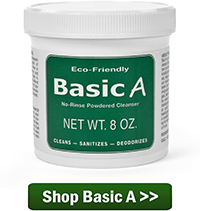
If you have been doing all the above, it is still possible for a mold or bacteria to contaminate a wine and cause these black spots to form in your wine. It’s just a little harder to know how it is happening. It could be from the corks, screw-caps or whatever you are using to close the wine bottle. It could be from a piece of equipment you are using that has a nook-or-cranny that is not getting sanitized sufficiently. It could also be something as blindsiding as the sulfites you are using are old and expired. Any and all things must be considered.
After having said all this, I would like to point out that if you had said the black spots where at the lower part of the wine bottle my answer would have been completely different. I would have attributed this to tannins dropping out of the wine. This is very common and expected with some wines. But the fact that you said the black spot were next to the air pocket makes all the difference in the world.
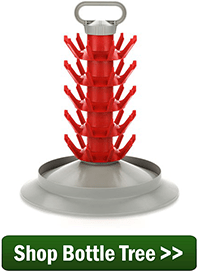 Any time there are black spots in your wine, there is reason for concern. At this point I would be very hesitant to drink the wine for fear of getting sick. It is possible to save the wine by putting it all back in a fermenter; add sulfites, and re-bottle. The sulfites will kill the mold or bacteria. However, I do not recommend doing this if there is any question to the smell of flavor of the wine. Adding sulfite at this point will only stop the wine from getting worse and make it safe to drink. It will not improve the wine’s flavor or aroma. So if the wine taste or smells bad now, don’t waist your time and effort. Dump it.
Any time there are black spots in your wine, there is reason for concern. At this point I would be very hesitant to drink the wine for fear of getting sick. It is possible to save the wine by putting it all back in a fermenter; add sulfites, and re-bottle. The sulfites will kill the mold or bacteria. However, I do not recommend doing this if there is any question to the smell of flavor of the wine. Adding sulfite at this point will only stop the wine from getting worse and make it safe to drink. It will not improve the wine’s flavor or aroma. So if the wine taste or smells bad now, don’t waist your time and effort. Dump it.
Best Wishes,
Ed Kraus
—–
Ed Kraus is a 3rd generation home brewer/winemaker and has been an owner of E. C. Kraus since 1999. He has been helping individuals make better wine and beer for over 25 years.
Do Wine Ingredient Kits Need Adjusting?
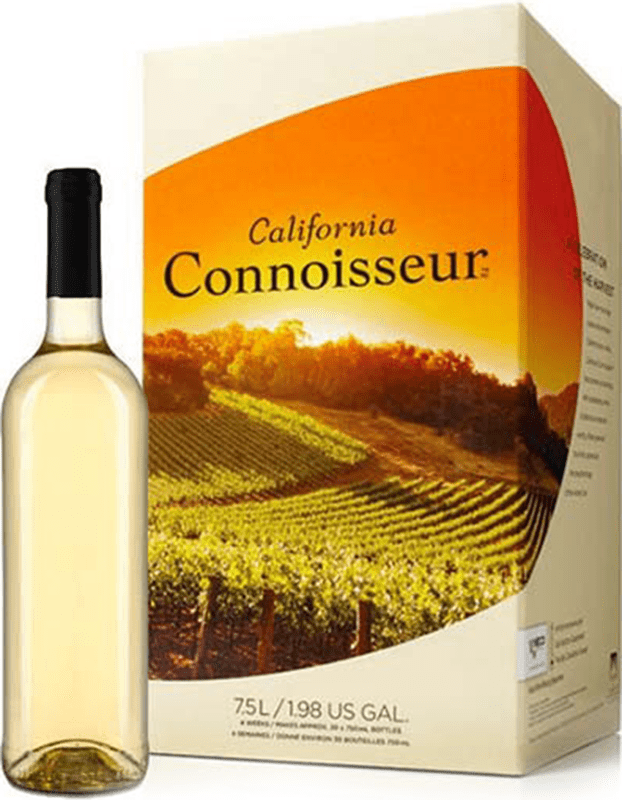 I purchased a California Connoisseur Merlot concentrate kit. Do wine ingredient kits need adjusting of any kind. Like does this concentrate consist of tannins? If it does, would it hurt to add tannin to help it’s staying qualities? Should I have an acid testing kit? If so, does the tannin have to be added during/before fermentation or can I put it in at any time? Are there any other adjustments that need to be made to these wine ingredient kits?
I purchased a California Connoisseur Merlot concentrate kit. Do wine ingredient kits need adjusting of any kind. Like does this concentrate consist of tannins? If it does, would it hurt to add tannin to help it’s staying qualities? Should I have an acid testing kit? If so, does the tannin have to be added during/before fermentation or can I put it in at any time? Are there any other adjustments that need to be made to these wine ingredient kits?
Doug B.
———-
Hello Doug,
Thank you for this great question about adjusting wine ingredient kits.
All of the wine ingredient kits we offer have been adjusted and bench-tested with sample batches to produce a balanced, stable wine with great flavor. Any attempts to make further adjustments with various wine making ingredients such as wine tannin, acid blend or flavorings are completely unnecessary and more likely to be counterproductive.
These wine ingredient kits come complete with all the additional packets of wine making ingredients you will need to add to the wine along the way. All that is required of you to make a perfectly balanced wine is to follow the instructions that are included with these wine ingredient kits.
T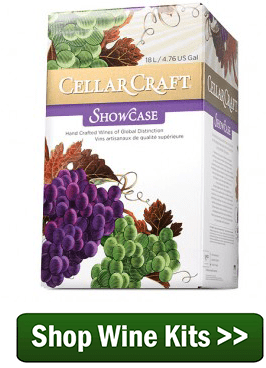 he producers of these kits crush the grapes and allow the juice to sit on the pulp until the right amount of flavor, color and body components are extracted from the grape skins into the juice. After the extraction process, the pulp is removed and the grape juice is concentrated, and sample batches of wine are made. It is at this time that any necessary adjustments are made to the grape concentrate for the sake of flavor balance and stability.
he producers of these kits crush the grapes and allow the juice to sit on the pulp until the right amount of flavor, color and body components are extracted from the grape skins into the juice. After the extraction process, the pulp is removed and the grape juice is concentrated, and sample batches of wine are made. It is at this time that any necessary adjustments are made to the grape concentrate for the sake of flavor balance and stability.
You can go ahead and make adjustments by adding other wine making ingredients to the wine must, however you will be running the risk of upsetting the stability and flavor balance of the resulting wine. In the case of adding tannin to a wine ingredient kit, you could be adding more than the wine will be able to saturate or hold within the liquid. This could result in the development of dark, dusty deposits in your wine bottles over time.
Doug, I hope this answers your question about adjusting wine ingredient kits. I hope you can start to see, a lot of care goes into the production process of these wine ingredient kits, so much so that they do not need any further adjusting of any kind. Once they are packaged they are ready to be made simply by following the directions that come with them. Add the additional packets as called for, and you will be making a stable wine with great balance and flavor.
Happy Winemaking,
Ed Kraus
—–
Ed Kraus is a 3rd generation home brewer/winemaker and has been an owner of E. C. Kraus since 1999. He has been helping individuals make better wine and beer for over 25 years.
Using Concentrated Grape Juice For Topping-Up
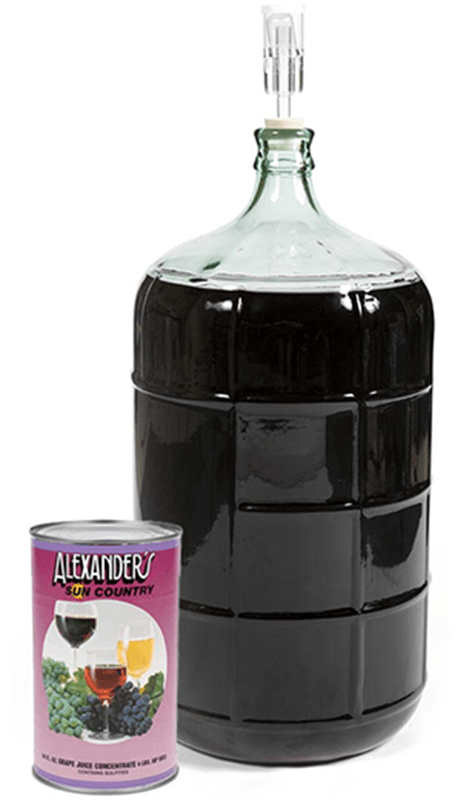 On the question of head space in the secondary fermenter–Can you add concentrate grape juice?
On the question of head space in the secondary fermenter–Can you add concentrate grape juice?
Gavin V. — GA
—–
Hello Gavin,
I’m assuming that you are referring to our resent blog post on ways to reduce head-space in a fermenter.
Certainly, topping up wine with concentrate is something that can be done, however realize that you are adding sugar. In fact, the concentrated grape juice is mostly sugar.
If the fermentation has completed, this will add more fuel for it to start up again. For this reason it is important that a wine stabilizer such a potassium sorbate also be added along with the concentrated grape juice. This will help to eliminate the chance of your wine having a re-fermentation.
If the fermentation has completed you do not want it starting up again. You will also need to take into consideration the more-obvious issue – that is – the concentrated grape juice will make the wine sweeter. If you want your wine to be dry, this would not be what you’d want to use top up your wine.
If the fermentation is still going, then adding the concentrated grape juice will increase the potential alcohol of the fermentation. There is always the possibility of  raising the alcohol level too much, bringing the wine out of balance. Very seldom will you ever want the total potential alcohol of a wine to go over 13%, and only then if your wine has a lot of flavor. Wines with higher alcohol will have a tendency to taste hot and less flavorful.
raising the alcohol level too much, bringing the wine out of balance. Very seldom will you ever want the total potential alcohol of a wine to go over 13%, and only then if your wine has a lot of flavor. Wines with higher alcohol will have a tendency to taste hot and less flavorful.
It is also important to understand that topping up wine with concentrate will also add more acidity to the wine. Just like there is a lot of sugar in the concentrated grape juice, there is a lot of fruit acid. It is possible that using it to top up your wine could make it too tart or sharp tasting. This is the case regardless if the wine is still fermenting nor not.
So, if your wine must is low in acid and you like your wine’s off-dry or even sweet, then topping up your wine with a grape concentrate may be a good option. But, other than this scenario, I do not think this is a great option for you.
Regular grape juice would be a much better choice.
Since the regular, un-concentrated, grape juice will have about the same acidity level as a wine, blending the two will not change the tartness of the wine to any noticeable degree.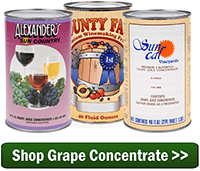
The sugar will still be a consideration. If you want your wine to stay dry as it would normally be after a fermentation, then grape juice – concentrated or not – would not be what you want to use. On the other hand, if you like your wines a off-dry or the wine is still fermenting, then grape juice might be something to consider.
Happy Winemaking,
Ed Kraus
—–
Ed Kraus is a 3rd generation home brewer/winemaker and has been an owner of E. C. Kraus since 1999. He has been helping individuals make better wine and beer for over 25 years.
